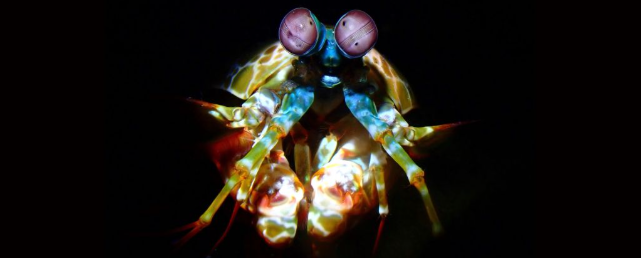


 11:40:11
11:40:11  2025-02-15
2025-02-15  911
911

Nothing else in the animal kingdom packs a punch like the mantis shrimp. This tiny, colorful crustacean delivers a wallop at 23 meters per second – a king-hit delivering a jaw-dropping 1,500 newtons of force to crack open the shells of their prey.
These blows are so powerful that scientists have wondered how the crustacean itself remains intact against the recoil effects.
Now, they've uncovered one of its secrets. The dactyl clubs that rain down mantis shrimp pain have a fascinating structure that filters out shocks, protecting the animal behind them.
"The mantis shrimp is known for its incredibly powerful strike, which can break mollusk shells and even crack aquarium glass," says mechanical engineer Horacio Espinosa of Northwestern University in the US.
"However, to repeatedly execute these high-impact strikes, the mantis shrimp's dactyl club must have a robust protection mechanism to prevent self-damage. Most prior work has focused on the club's toughness and crack resistance, treating the structure as a toughened impact shield.
"We found it uses phononic mechanisms – structures that selectively filter stress waves. This enables the shrimp to preserve its striking ability over multiple impacts and prevent soft tissue damage."
The punch of the mantis shrimp has been studied in detail. As it moves through the water at high speed, it produces what is known as a cavitation bubble. As water is pushed aside at high speed, its density lowers to the point that water within the low-density bubble vaporizes.
But this bubble, surrounded by higher-density water, can't last long: it immediately implodes in a burst of heat, light, and sound.
It is the energy released by this collapsing bubble that can crack shells (and aquariums).
"When the mantis shrimp strikes, the impact generates pressure waves onto its target," Espinosa says. "It also creates bubbles, which rapidly collapse to produce shockwaves in the megahertz range. The collapse of these bubbles releases intense bursts of energy, which travel through the shrimp's club. This secondary shockwave effect, along with the initial impact force, makes the mantis shrimp's strike even more devastating."
Yet the mantis shrimp is unscathed by this tremendous shock, which should generate outwards in all directions.
To figure out why, a team led by engineer Nicolas Alderete of Northwestern University took a detailed look at the dactyl clubs of the peacock mantis shrimp to see if it could yield any clues.
They used two techniques such as picosecond laser ultrasonics and transient grating spectroscopy on the creature's armor to see how it responded to propagating stress waves – and they found that the dactyl clubs are uniquely structured to dampen and filter these waves to protect the mantis shrimp.
We already knew that the structure of the armor of the dactyl club is layered, a bit like a lasagne. The impact surface is a fine layer of hydroxyapatite, a mineral mostly made up of calcium and phosphorus, like the coating of your teeth. The impact region directly beneath consists of a layer of chitin fibers arranged in a herringbone pattern that optimizes structural integrity.
And, directly beneath that is a layer of chitin fiber bundles arranged in a corckscrew-like structure, each bundle of which is rotated just a little bit more than its neighbors. This layer forms what is known as a Bouligand structure, known to increase fracture resistance.
What the researchers discovered is that this layer also acts as a phononic bandgap shield – a material that filters out sound and stress waves by controlling how those waves interact with the material's periodic structures. The Bouligand structure of the chitin in the dactyl club of the mantis shrimp does exactly that.
"The periodic region plays a crucial role in selectively filtering out high-frequency shear waves, which are particularly damaging to biological tissues," Espinosa explains. "This effectively shields the shrimp from damaging stress waves caused by the direct impact and bubble collapse."
The team plans to design and perform underwater experiments to observe the efficacy and limitations of this marvelous armor – perhaps with an eye towards future bio-inspired material design.
Reality Of Islam |
|

"It is

The process

Astronomers

Cosmologist
 9:3:43
9:3:43
 2018-11-05
2018-11-05
10 benefits of Marriage in Islam
 7:5:22
7:5:22
 2019-04-08
2019-04-08
benefits of reciting surat yunus, hud &
 9:45:7
9:45:7
 2018-12-24
2018-12-24
advantages & disadvantages of divorce
 11:35:12
11:35:12
 2018-06-10
2018-06-10
 6:0:51
6:0:51
 2018-10-16
2018-10-16
 8:25:12
8:25:12
 2022-03-09
2022-03-09
 10:35:40
10:35:40
 2022-05-26
2022-05-26
 10:47:11
10:47:11
 2022-11-22
2022-11-22
 6:28:21
6:28:21
 2022-12-20
2022-12-20
 7:34:7
7:34:7
 2023-02-28
2023-02-28
 2:2:13
2:2:13
 2022-10-08
2022-10-08
 1:38:41
1:38:41
 2021-12-08
2021-12-08
 5:41:46
5:41:46
 2023-03-18
2023-03-18
| LATEST |